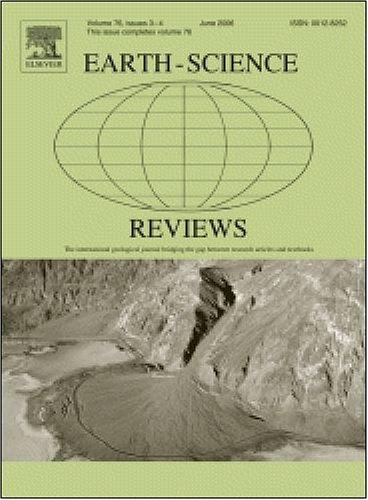A review of 3.7 Ga stromatolites from the Isua Supracrustal Belt, West Greenland
IF 10.8
1区 地球科学
Q1 GEOSCIENCES, MULTIDISCIPLINARY
引用次数: 0
Abstract
This paper reviews the origin of putative stromatolites within 3.7 Ga meta-dolostones from the Isua Supracrustal Belt (Greenland) as either bona fide biogenic structures, as other (abiogenic) types of primary sedimentary structures, or as the products of structural deformation.
Regional mapping shows that primary structures are preserved locally across a range of lithology, specifically within the hinge zones of fold structures. Examples of such primary structures – bedding, cross-bedding, and edgewise conglomerate – within the fold structure that hosts the stromatolites, which have been discounted by some as the products of high strain, are here re-affirmed to be primary structures. Importantly, this demonstrates the potential of localised exceptional preservation. Critically, bedding and cross-bedding are defined by a combination of compositional variations and grain size that, together with an asymptotic geometry of the latter present an uniquely compelling case against the formation of these features through shearing and deformational tectonic forces.
The stromatolites can be discriminated from either primary sedimentary flame structures caused by sediment loading, or sand volcanoes caused by dewatering. Similarly, they can be discriminated from necking structures formed by tectonic boudinage on geometrical grounds, nor are they boudins themselves as they are asymmetrical and irregularly spaced. They are also clearly distinct from small-scale fold structures because of the repeated flat-base versus conical-top geometry of the stromatolites across four individual layers.
Instead, the putative stromatolites display characteristic features consistent with formation as biogenic structures. They occur in specific horizons that lie within a well-preserved stratigraphy, have flat bases and coniform to domical upper surfaces, display internal laminations, and are made of dolomite with REE + Y and stable isotopic values consistent with deposition in a biologically-influenced shallow sea. They are strained structures, elongated along the plunge direction of the regional synformal anticlinal fold in which they occur (i.e., the X-axis of the local strain ellipsoid). Importantly, 3-D observations show that the coniform stromatolites taper in the finite extension direction and that overlying mica-rich meta-dolomite beds lap onto the stromatolites in all dimensions.
In conclusion, the Isua stromatolites conform to known biogenic structures from throughout the geological record, both in terms of their overall setting, but also their unique geometry that is clearly distinct from any other known mechanism of formation. Their preservation is best explained by their occurrence within a fold hinge that has experienced plane strain in a small domain that escaped infiltration by H2O-rich metamorphic fluids into siliceous meta-dolostones.
西格陵兰岛Isua上地壳带3.7 Ga叠层石的研究
本文综述了格陵兰岛Isua上地壳带3.7 Ga变质白云岩中假定的叠层石的起源,这些叠层石要么是真正的生物成因构造,要么是其他(非生物成因)原生沉积构造,要么是构造变形的产物。区域测图表明,在一系列岩性中,特别是在褶皱构造的铰链带内,局部保存着原始构造。这种原生构造的例子——层理、交叉层理和边缘砾岩——位于叠层石的褶皱构造中,被一些人认为是高应变的产物,在这里被重新确认为原生构造。重要的是,这表明了本地化特殊保护的潜力。重要的是,层理和交错层理是由成分变化和粒度的组合来定义的,再加上后者的渐近几何形状,这是一个独特的令人信服的案例,反对这些特征是通过剪切和变形构造力形成的。叠层石既可分为沉积负荷作用下的原始沉积火焰构造,也可分为脱水作用下的沙火山构造。同样,它们在几何上可以与构造束缚形成的颈缩构造区分开来,但它们本身也不是束缚,因为它们是不对称的、不规则的间距。它们也明显不同于小规模褶皱结构,因为叠层石在四个单独的层上重复呈现平底和锥形顶部的几何形状。相反,假定的叠层石显示出与生物成因结构相一致的特征。它们出现在特定的层位,位于保存完好的地层中,具有平坦的基底,与圆顶上表面一致,显示内部层状,由具有REE + Y和稳定同位素值的白云岩组成,与生物影响的浅海沉积一致。它们是应变构造,沿着它们所在的区域同型背斜褶皱的俯冲方向(即局部应变椭球的x轴)被拉长。重要的是,三维观测表明,平直叠层石在有限的延伸方向上逐渐变细,而上覆的富含云母的变质白云岩层在所有维度上都与叠层石重叠。总之,Isua叠层石符合整个地质记录中已知的生物成因结构,无论是就其整体环境而言,还是就其独特的几何形状而言,都与任何其他已知的形成机制明显不同。它们的保存最好的解释是,它们出现在一个褶皱铰链中,在一个小区域内经历了平面应变,逃脱了富氢变质流体进入硅质变质白云岩的渗透。
本文章由计算机程序翻译,如有差异,请以英文原文为准。
求助全文
约1分钟内获得全文
求助全文
来源期刊

Earth-Science Reviews
地学-地球科学综合
CiteScore
21.70
自引率
5.80%
发文量
294
审稿时长
15.1 weeks
期刊介绍:
Covering a much wider field than the usual specialist journals, Earth Science Reviews publishes review articles dealing with all aspects of Earth Sciences, and is an important vehicle for allowing readers to see their particular interest related to the Earth Sciences as a whole.
 求助内容:
求助内容: 应助结果提醒方式:
应助结果提醒方式:


